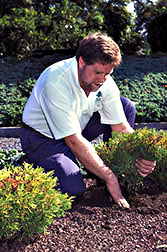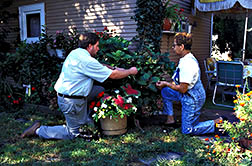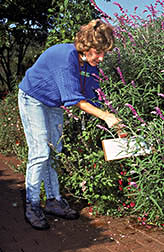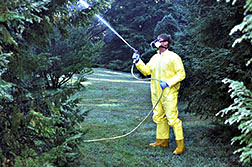Arboretum Leads Low-Chemical Landscape Movement
 To combat Southern blight, the arboretum's IPM coordinator, Scott Aker, raises a Thujopsis dolobrata so its crown is slightly above soil level. (K7049-1) |
The Nation's garden has changed its habit of spraying chemicals routinely.
The total volume of pesticides sprayed at USDA's National Arboretum in Washington, D.C., has dropped by about three-fourths since a new landscape pest management program began in 1992. And the plants are doing better than ever.
The only spraying now done al the arboretum is spot spraying—right where it's needed and only when and if it's needed. The shift toward monitoring and away from blanket spraying has resulted in a two-thirds reduction in total pesticide costs. Other savings include reduced employee risk and liability and lower expenses for safety equipment and health monitoring.
The arboretum is a 444-acre living museum set up by the U.S. Congress in 1927 to do research on trees, shrubs, and flowers and to educate the public on their care. Since its founding, it has released more than 640 new plant varieties.
Along with the reduction in total volume of pesticides used, the arboretum has made a major shift toward the use of less-toxic pesticides. The percentage of so-called bioregional pesticides—those with less negative environmental impact—has risen from 12 percent of the total used to 32 percent. They include horticultural oils, insecticidal soaps, and insect growth regulators.
Scott Aker, the horticulturist who developed the arboretum's landscape IPM (integrated pest management) program, says that biorational pesticides are just about the only new kinds of pesticides being developed for landscapes today.
Aker explains that IPM is a package of practices to briny pest levels down to tolerable levels, using chemicals as a last resort. But rather than being anti-pesticide, IPM is pro-planning, he says.
 Horticulturist Scott Aker discusses pest problems with Mattie Coates, an arboretum neighborhood resident who volunteered her yard as a case study for an IPM workshop. (K7049-2) |
"IPM is really the first organized way to manage pests, in which chemicals become just one tool whose use must fit into the entire scheme. The choice is not chemical or no chemical," Aker notes, "but planning or no planning. The planning often eliminates the need for reactive spraying, when it's often too late to do any good."
IPM has been used on farms for more than two decades, but its use on landscapes is new. Aker is excited about the challenge of transferring IPM and other environmental practices from farm to landscape.
The arboretum's vast and diverse landscaping makes pest management more difficult, overall, than it would be at an average home or smaller site. But the diversity itself helps prevent some pest problems.
Before you go away thinking this IPM program won't work at your house, just walk around the corner from the arboretum and talk to Mattie Coats. Her tidy bungalow is part of a beautiful neighboring community of mature homes (many of them 1920's- and 1930's-era homes), mature people (mostly retirees), and mature landscapes.
At his first annual landscape IPM workshop for the public this past summer, Aker's students—landscaping professionals—spent three mornings inspecting Coats' front and back yards, as well as those of her next-door neighbor and others on her block (with their permission, of course).
Aker believes strongly in the arboretum's educational mandate and is currently acting as head of its education unit.
His students peeked into shrubs, looked up trees, turned over leaves, took notes, and held discussions all around the homes. They drew landscape maps, noting the locations of pest problems on them. They also used the white surface of their maps for the "beat test."
Aker showed them how to sample for pests by beating the bushes over a sheet of paper on a clipboard held ready to catch whatever fell out. He gave each student a 10-power magnifier to help in identifying the pests.
Back in the classroom, they discussed the results. The consensus for the two adjacent homes was that—while almost everything looked fine and the yards showed a lot of tender, loving care—there were overriding problems with mites and aphids because too many similar plants were being grown.
The answer was not more pesticides, but removing some of the plants that were causing problems—especially if they were not particularly valued—and adding new and different plants.
 Joanne Lutz, an IPM Wallace Genetic Foundation Fellow, uses a "beat test" to find pests on salvia. (K7049-3) |
Aker says that people have to learn to think of the landscape as evolving and dynamic, not "set in stone" forever. For example, he says, one of Coats' neighbors has a severe pest problem on her sweet peas, and she's tired of the plants. Again, the answer is to switch plants—from sweet peas to a plant better suited to her tastes and the landscape.
Many times, both around homes and at the arboretum, pest problems are caused by plants growing in the wrong place, which no amount of pesticide can fix.
Aker would later refine the landscape maps made on site and the accompanying pest control suggestions and give them to the neighbors in appreciation for their generosity in allowing so many landscape experts to probe every secret of their yards.
Aker makes two points about landscape IPM. First, it's different from farm IPM because landscape plants vary more by species, age. and height than farm crops do. "The yard even the smallest home can have hundreds of species of plants, compared to the one species typical in corn or soybean fields in the Midwest," he says.
Second, even farm IPM professionals have to use some art and common sense, in addition to the science of monitoring insect populations.
One key IPM concept is the idea of a threshold, or level of infestation at which it would be economically worthwhile to spray. As one farmer puts it simply: "IPM means that I don't spray until the pests threaten to rob enough bushels of corn to more than equal the cost of spraying."
Farmers know when that point is reached because experts have calculated that they should use insecticide when, for example, they have a certain number of corn borers per cornstalk on a sampling of plants.
It's not quite that simple with a landscape, where the threshold is not as clearly defined.
For gardeners, the threshold is often more aesthetic than economic—and often more personal. For example, for some families, a tree planted as a memorial must be saved at all costs, which lowers the pest threshold point.
Aker says the landscape IPM threshold is more akin to a housekeeper's pain threshold for dust than it is to a farmer's economic threshold, where yield is the bottom line.
"The hour before a guest is due, your threshold for dust—the amount you'll tolerate—goes way down in those parts of the house the guests will see most of," he says. "The same goes for landscape plants. If you have a backyard barbecue, your tolerance for weeds and other pests goes way down for plants within sight."
Like a homeowner preparing for visitors, Aker gives priority to plants near the main attractions of the arboretum, especially during the tourist season.
In discussing establishment of thresholds, Aker tells his students that "damage is one thing; death is another. Gardeners should evaluate the seriousness and longevity of the problem," he says. "For example, if a pest is ruining a plant's looks near the end of the season, you can afford to let the pest have its way—essentially negating the threshold—as long as it won't affect the plant's long-term health."
The price of plants, chemicals, water, mulch, and other supplies makes the homeowner's threshold partly economic. But unlike a farmer or nursery owner, a homeowner’s livelihood is not at stake. Homeowners have more margin for error, so their thresholds are higher.
Scouting is another key IPM concept. In the case of farmers, they pay consultants to go through fields every week or two, sampling crops and keeping records to support recommendations to farmers. At the arboretum, Aker, Bill Craft, and Joanne Lutz do their scouting constantly as part of their work.
A typical summer day might find Aker scouting one of the arboretum's numerous collections. This morning it's the National Bonsai Collection, which is both an indoor and outdoor display. The outdoor section is a series of pavilions, with many plants used to decorate the gardens around the bonsai trees.
Aker begins each visit with a map of the bonsai collection on a clipboard, just as he had his students do in the neighborhood yards.
He walks up to various trees and shrubs and whacks the leaves, hard enough to shake any pests onto the white surface of the map paper but not so hard as to damage the plants. He looks at the pests on the paper, using a 20-power magnifier if necessary.
Aker rounds numbers off broadly, more interested in whether there are many more or less than 20 to 50 pest miles on a plant per test.
 In the arboretum's IPM program, less toxic pesticides such as soap, Bt, and oil are used whenever possible and are applied on a plant-by-plant basis. (K7049-4) |
He also looks for predators, saying that two predatory miles can totally erase any concern he would normally have at a 50-plus count for the bad mites. "That's because one predator can eat from 20 to 50 pest mites or eggs in a day, which is faster than the miles can reproduce," he says.
The mites occasionally get ahead of Aker and crew. Brown needles on the 35-foot-tall Japanese cedars overhanging the pagoda gate to the bonsai collection are one result. While the conifer collection in general has been the biggest success of the arboretum's landscape IPM program, mites made a sneak attack on these cedars in the fall of 1994, when they were not expected. Craft drenched the trees with horticultural oil to stop the infestation.
Now, Aker notes, the trees have 6 inches of new growth above the brown needles and are recovering nicely. "They'll shed the brown needles this winter and will look better next spring," he says, indicating no further action is needed. "I've learned to keep a close eye on them as we head into October."
The drenching of the Japanese cedars with oil shows that Aker is not afraid of spraying. When he asks Craft to spray horticultural oil on a 30-foot tree, he expects to find the tree coated with the waxy oil.
That's because he doesn't want half-hearted measures that don't work and lead to more drastic measures, such as the use of chemical pesticides later. The oil has to cover all the pests on the tree in order to smother and suffocate them.
Aker is proud of the conifer IPM success story at the arboretum. The conifers have much less of a pest problem today than they did 3 years ago, when pesticides were used routinely.
He has controlled the pests better with a combination of scouting, pruning, removal, replacement, oils, and releases of predatory mites.
With a landscape IPM program as the basis, Aker believes in quick action where needed and no action when appropriate. For example, he looks at the yellowing leaves on a hedgerow of Japanese holly shrubs lining the base of a wall near the bonsai collection and arboretum administration building.
"The yellowing is related to drought and compacted soil. But the plants need to be replaced anyway, so we'll do nothing. Since Japanese holly is not tolerant of the conditions here, we may want to try something more suitable for the site," he says.
Aker also has a nearby hemlock tree slated for removal once it dies. "It's the wrong plant for the hot, sunny spot it's in," he says.
But he is not so cavalier about the museum-quality pieces at the heart of the collection: the bonsai. Here there is literally no threshold; any pest—even one pesky mite—is a serious threat requiring action.
"The value of IPM for these bonsai is that we take a close look for pests and can get on top of a problem early in the game," he says.
The centuries-old bonsai have the low-to-nonexistent threshold both because of their value and because by definition they are always living under extreme stress, making them more vulnerable to pest damage.
They seem particularly vulnerable after almost a month of drought. Although the plants are watered, they, like the other plants at the arboretum, can suffer the effects of a succession of hot, low-humidity days. Aker has seen so many plants whose leaves have turned brown from the scorching weather pattern, that he tires of writing the word "scorch."
Aker gives the 2-foot-high bonsai the same—albeit more careful—treatment he gives the 35-foot specimens: the beat test, the magnifying lens, and careful observation of the leaves and trunks.
He moves to a recreation of a miniature bald cypress swamp, removing some suspect needles for observation under the magnifier.
He slips in and out of display areas among the bonsai versions of trees of the world, including western hemlock, European olive, coast redwood, pink-flowered crape myrtle, and scotch pine.
Later, Aker will talk to the bonsai collection's curator and exchange information. Then he will discuss his recommendations, based on the curator's goals. He says the entire staff of the arboretum has learned to keep an eye out for pests and diseases and often shares valuable information that helps him keep up-to-date.
Aker says that landscape IPM begins and ends with people, relying more on them than on chemicals or machines. His job makes him part detective, part psychologist, and part businessman.
He listens to people carefully, because their goals affect his recommendations; he lets himself be influenced by their comments and, in turn, influences them.
In fact, Aker sees changing human behavior as one of IPM's most important pest control tactics.
"People have to get away from the idea of reaching for a spray can the minute they see one bug on a plant," he says. "They have to realize, for one thing, there may be another bug lurking nearby waiting to eat the first bug. A spray could kill both bugs, or deprive the harmless predatory bug of a meal." – By Don Comis, ARS.
"Arboretum Leads Low-Chemical Landscape Movement" was published in the January 1996 issue of Agricultural Research magazine.






